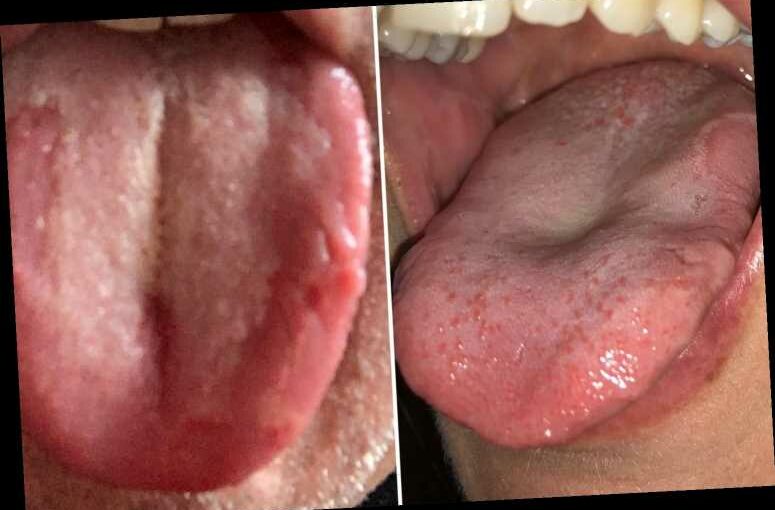WHILE we all know the three main signs of Covid-19, some people have been struck down with lesser known symptoms.
Many patients have displayed "Covid tongue" and experts have urged the government to add it to the official list of signs, but what does the symptom look like and how can you spot it?
😷 Read our coronavirus live blog for the latest news & updates
Experts fear as many as one in five cases of Covid-19 are being missed because the unusual sign isn't being formally recognised.
The three key symptoms of Covid-19 are a new persistent cough, a loss of taste and smell (anosmia) and high temperature.
If you have any of these symptoms you should isolate and get a test.
However, it was also revealed this week that people who contracted the variant that originated in Kent typically displayed different symptoms.
People suffering from this mutation are more likely to get a cough, sore throat, tiredness and muscle pain, the Office for National Statistics (ONS) revealed.
What to look out for?
The experts behind the ZOE Symptom Study app have been asking users to send in photos of their Covid tongues.
Many people have responded and one of the main signs of Covid tongue is if your tongue appears to be swollen.
If it's swollen it could feel sore and as though it's taking up more space in your mouth than usual.
The NHS says that biting or burning your tongue with hot food can lead to it being sore but that this should go away within a few days.
Another way to spot Covid tongue is if you have small red or white bumps on the surface or the sides.
These little bumps can sometimes be down to the body experiencing stress.
Other reasons you might have these little bumps could be because of your hormones or certain foods.
The experts say that some people have also been displaying unusual mouth ulcers after contracting Covid-19.
The NHS said that mouth ulcers are common and should clear up within a week or two.
Professor Tim Spector, an epidemiologist at King's College London (KCL), said on Twitter: "One in five people with Covid still present with less common symptoms that don't get on the official PHE [Public Health England] list – such as skin rashes.
"Seeing increasing numbers of Covid tongues and strange mouth ulcers."
That means up to 20 per cent of Covid cases could be going unaccounted for, leaving those people more likely to unknowingly spread the virus.
He urged people to continue sending him pictures of their "Covid tongues" – when the mouth rash is coincided with fever and fatigue.
IMPORTANT SIGNS
Prof Spector has previously called for the NHS to expand its list to ensure Covid cases are spotted in the early stages.
His team were among the first to spot that a loss of taste and smell could be an indicator of the virus and successfully had it added to the official list.
Experts first said skin rashes in the mouth should be recognised as an important sign of Covid-19 back in September.
Researchers examined 666 patients at a temporary field hospital that had been set up at the peak of the pandemic in Madrid, Spain.
Experts revealed that 46 per cent of patients had some form of skin rash, with the hands and feet being particularly affected.
They also found that 26 per cent of patients had a rash inside the mouth and small bumps were the most common signs.
Gabriel Scally, a public health physician and president of epidemiology and public health at Royal Society of Medicine, told The Sun: "Symptoms in the mouth have been described for some time in association with Covid-19.
"It is such a problematic virus to treat as it produces effects in such a wide range of body systems."
Prof Scally said: "The medical name for an acute swelling of the tongue that occurs as part of a syndrome is 'glossitis'.
"It can also involve discolouration and can also be known, more popularly than medically, as 'strawberry tongue' or 'raspberry tongue' in these cases.
"It can occur in a wide range of conditions."
Certain diseases that affect the immune system may attack the tongue, including herpes.
Changes in the tongue, including pain, discolouration, swelling or a strange texture, are sometimes the result of an underlying condition.
But they can also be the result of poor mouth hygiene, smoking or an unhealthy diet.
A white or "furry" tongue is often caused by coating of debris, bacteria and dead cells.
But it could be a sign of a health condition, for example oral thrush, and the NHS advises seeing a GP about it.
Mouth ulcers are very common and can be caused by a range of things, including hot food or drink, medicines, stress, hormonal changes or vitamin deficiencies.
Source: Read Full Article




